Resource
Ultimate Book Drive
DIY Project
Civic Circle® Area: Donate
The impact of COVID-19 continues to change our daily lives and routines, but volunteering and civic engagement are just as important as ever. This project can be modified to adhere to social distancing guidelines set by local and national authorities, to do virtually or to do at home and deliver via mail or drop off.
There are kids around the world who don’t have access to books, whether because of money or a lack of access. You can help those kids get books by holding the best book drive your community has ever seen, using these foolproof instructions from our book drive pros.
Why Is It important?
Studies show that access to books is key to reading achievement. In middle-income neighborhoods, there are an average of 13 books per child. In poorer neighborhoods, there is only approximately one book for every 300 kids, so kids often have no children’s books at home.
What You Need:
- Collection boxes or bins
- Large posters
- Markers, crayons and/or coloring pencils
- Phone
- Printer
Steps:
Before the Drive:
- Decide whom you would like to help and contact them to find out their current needs. You could contact a library serving disadvantaged children, shelters and clinics serving children from low-income neighborhoods, hospitals, etc.
- Gather a group of friends to help you share the responsibilities.
- Determine the length of the book drive. Book drives typically run from two weeks to a month so that donors have sufficient time to review information about the drive, select books from their personal libraries and bring them to the drop-off locations.
- Make colorful posters asking people to support you by donating books. Include all the details: the purpose of the drive, the drop-off location(s), dates of the drive, what books to bring and in what condition (new, mint condition and gently used books preferred) and your contact information should anyone have questions about your campaign. If you are artistic, you can make a poster, or you can ask a classmate or friend to help you with that. Make sure you check with an adult about the contact information to include. You might want to set up a new email account for the purpose of the book drive. Consider making a digital poster to share on social media.
- Get the word out! Post on social media, and hang the posters in libraries, local stores and your school. Make sure you get permission to hang the posters.
- Get your hands on some boxes or bins. Boxes should be strong enough to hold a large number of books. You can use old boxes from your house or get them donated from local supermarkets. You can also use 18-gallon plastic storage bins if you can borrow them from friends and family for the duration of the drive. If you can get your hands on boxes with cut-out handles, they work best!
- To make sure your book collection box grabs people’s attention, go wild decorating the box. Make sure you include details on what books to bring (and in what condition) on one side of each collection box and also contact information (see #4). This way, if anyone is interested in putting a book collection box at their store or organization, they know who to get in touch with.
- If you want to design a logo for your book drive, be sure to include this on your poster and on your collection boxes.
During the Drive
- Set up the collection boxes for your drive. Make sure you get permission before you set them up. Boxes should be placed where they will be most visible, such as in an entryway or lobby.
- Send a press release to your local media about your book collection drive so your community will have an opportunity to help. Include who, what, when, where, how and why. Some papers prefer the information to be in the body of an email and others want attachments. Call the individual papers for guidance. Include a good photo to publicize your upcoming event. Follow up with a phone call once you have emailed your press release to ensure that it has been received.
- Go through your own personal library and donate any books you have outgrown. Ask your friends, family and neighborhood to do the same.
- Empty the collection boxes periodically to make sure there is room for people to continue to donate.
- To promote your drive online, use a social media hashtag (like #NHBdrive) and create an open Facebook event. Don’t forget to tweet about how your drive is coming along. Post photos and success stories to motivate more people to help you.
After the Drive
- At the end of your drive, gather all the books and sort them. It is typically a good idea to sort them based on age group and hardcover or paperback. Then box them up based on where the books are going to be delivered.
- Once this is done, ask an adult to help you deliver the books. Pack your books in manageable boxes or sturdy bags.
- Don’t forget to clean up after the drive! Remove posters, fliers and other materials from walls once the book drive is finished.
- Share your results online as well as with your local community so you can inspire other kids to get involved.
- Newspapers love photos, especially shots of kids or teens engaged in the activity. Send a press release out to highlight your successfully completed book drive.
Reflection Questions:
- How did organizing this project change you and what did you learn from it?
- Did you make a difference? Why or why not? What impact did you have?
- Are there other ways that you can help underprivileged children?

